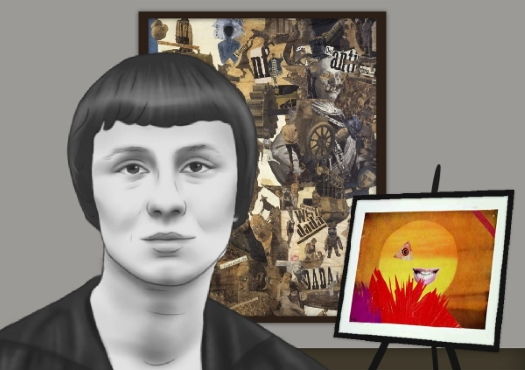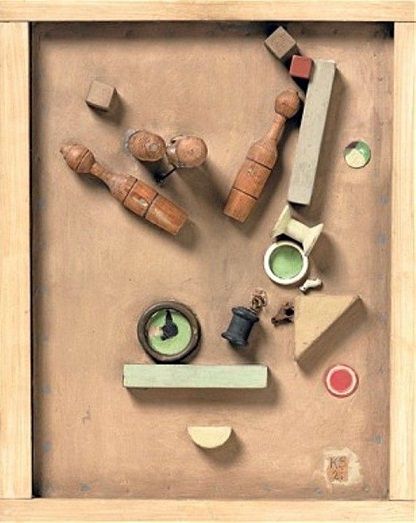Summary of Hannah Höch
Höch was not only a rare female practicing prominently in the arts in the early part of the 20th century - near unique as a female active in the Dada movement that coalesced in her time - she also consciously promoted the idea of women working creatively more generally in society. She explicitly addressed in her pioneering artwork in the form of photomontage the issue of gender and the figure of woman in modern society. Her transformation of the visual elements of others by integrating them into her own larger creative projects evidenced a well-developed early example of "appropriation" as an artistic technique.
Accomplishments
- Höch was a key progenitor of the self-conscious practice of collaging diverse photographic elements from different sources to make art. This strategy of combining formerly unrelated images to make sometimes startling, sometimes insightful connections was one that came to be adopted by many Dada and Surrealist artists of her era, and also by later generations of "post-modern" conceptual artists in other media, including sculptural installations, mixed media and moving images, as well as in still photography.
- Höch also helped expand the notion of what could be considered art by incorporating found elements of popular culture into "higher" art. She was one of many Dadaists to take advantage of such means, but she was both among the first, and one of the most self-consciously explicit in describing the goals and effects of doing so.
- A political iconoclast, she actively critiqued prevailing society in her work, and, implicitly, through many of her life choices. Her active interest in challenging the status of women in the social world of her times motivated a long series of works that promoted the idea of the "New Woman" in the era.
The Life of Hannah Höch
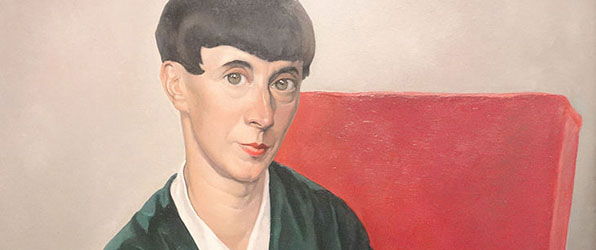
Saying, “I always had an experimental turn of mind,” Hannah Höch transformed her experience working with textiles and mass media images for commercial women’s magazines into pioneering Dada photomontages with a gender-bending feminist slant.
Important Art by Hannah Höch
Dada Puppen (Dada Dolls)
Höch's darkly playful Dada Dolls are quite distinct from any work created by the others in the Berlin group of Dada artists with which she was affiliated early on. Given that the Berlin chapter of Dadaists only formed in 1917, these small-scale sculptural works suggest her awareness of Dada ideas more generally from its inception in 1916 in Zurich. She was likely influenced by writer Hugo Ball, the Zurich-based founder of Dada, given Höch's doll costumes' resemblance to the geometric forms of Ball's own costume worn in a seminal Dada performance at the Swiss nightclub Cabaret Voltaire.
Ball achieved notoriety for his declamation there of sound poetry, which he recited while wearing a mechanical looking outfit comprised of geometric shapes. The costume can be read as a commentary on contradictory feelings held towards developing technology. Technology was both revered and feared at this time, since it both aided social and economic progress but also threatened humanity with its destructive power. A common belief among Dadaists was that technology caused humans to become more machine-like themselves. One intent of the Dada movement was to use art as a satirical critique of such elements of culture that were both intimidating and absurd.
As Paul Trachtman has portrayed it, in a description that is apt for both Ball's and Höch's work: "When Dadaists did choose to represent the human form, it was often mutilated or made to look manufactured or mechanical. The multitude of severely crippled veterans and the growth of a prosthetics industry struck contemporaries as creating a race of half-mechanical men."
Fabric, yarn, thread, board, and beads - Berlinische Galerie. Landesmuseum fur Moderne Kunst, Fotografie und Architektur
Heads of State
Heads of State is built around a newspaper photograph of the German president Friedrich Ebert and his Minister of Defense, Gustav Noske. Having carefully cut the men out, Höch proceeded to create a composition with characteristically disjunctive and unexpected outcomes. The two statesmen look decidedly foolish out of context in their bathing suits, and Höch places them against a background of an iron-on embroidery pattern of flowers and butterflies surrounding a woman. At this point, in time she was still working for magazines designing similar patterns, and this work is testament to her ability to converge her disparate experiences to create new and striking images.
The effect is deliberately comical, but it also sends a powerful message. The President and his minister, who had recently and ruthlessly put down the Spartacist Rebellion, are presented frolicking in a whimsical fantasy land, as if they are unaware of the intense hardships and political and financial problems being faced by Germany and its citizens during this period.
The embroidery-pattern background alludes to a source of income and occupation for many German women at this time, including Höch herself, and serves to contrast the role of women with that of men. The collage is arranged so that it looks like the two figures have been caught in the net of the embroidery pattern, and it positions these paunchy heads of state as worthy of ridicule in the process of stripping them of their usual trappings of masculinity. At the same time, the composition attacks the patriarchy and questions the arbitrary values projected onto different art forms by society.
Photomontage
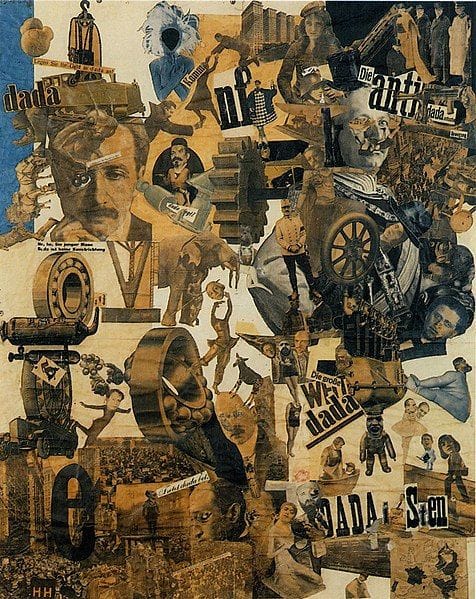
Cut With the Kitchen Knife Through the Last Weimar Beer-Belly Cultural Epoch in Germany
Though one of Höch's earliest works, this ambitious collage is unusual within her canon for being particularly large; it measures 35 x 57 inches. Here she uses cuttings from newspapers and magazines to create one cohesive image out of a myriad of disparate parts. This technique of taking words and images from the established press to make new and subversive statements was highly innovative.
The piece was exhibited in the First International Dada Fair, which took place in Berlin in 1920, and it was reportedly one of the most popular pieces in the show. In the top right corner Höch has pasted together images of "anti-Dada:" figures of the Weimar government and representatives of the old empire. Elsewhere in the collage, the proponents of Dada including photographs of Raoul Hausmann are ranged in opposition to these establishment figures.
The effect is initially one of visual confusion, and yet a kind of nonsense-narrative begins to develop with sustained attention. One figure is transformed into something else by the addition of a de-contextualised newspaper clipping, such as the Kaiser's iconic moustache replaced by a pair of upside-down wrestlers. The work encapsulates the eclecticism and eccentricities of Dadaism, but also makes a pointed political statement against the staid establishment; it is a carefully-crafted homage to anarchistic opposition.
Photomontage
High Finance
Höch's High Finance is a perfectly composed example of her innovative photomontage technique. The viewer is presented with two banker figures, each with a disproportionately large and mismatched head, one of which is a photograph of 19th-century British chemist and astronomer Sir John Herschel. The effect would be comical, were it not for Höch's intelligent arrangement of the other visual elements. One of the bankers' heads is spliced cleanly in half, and behind it are two shotguns, which look as if they are simultaneously being aimed by and at the banker.
She offers a satirical view of industrialism and financial power in post-First World War Germany, pointing to the hidden link between military complexes and the bankers who finance them. However, the issue is complex, and this comes across in her imagery. The two men carry menacing mechanical tools, but the hand of the man on the left seems to have been taken over by the piston, while his face (cut from a grainy newspaper) is obscured by the trigger of the sharp illustration of a gun.
She presents an image of a world poised on the edge of chaos. The composition is arranged carefully to create an inherent balance, but the implication is that if one small element were relocated, the whole would be pushed out of order, much like in the world of "high finance" that is depicted.
Photomontage
Untitled, From an Ethnographic Museum
This work comes from a series of images made by Höch around 1930. They are said to have been inspired by a trip to an ethnographic museum with her partner Til Brugman. The image makes powerful use of tropes of display, such as the clear framing border, the expansive sea of the red color-field background and the blue rough semi-circle that acts as a plinth for the central figure.
Höch's view of non-European art and Western receptions of it seems implicitly to be more critical and nuanced than that of many other artists at this time, who often saw the 'primitive' artwork as containing an essence of vitality that had been lost in artistic developments in the West. She presents a new image of this art; offering viewers a visual reminder to be conscious that they are seeing the image of this sculpture without context and thus stoking a desire for the erotic and exotic.
Höch combines this imagery of the non-Western sculpture with a picture of a beautiful woman from the European popular press, distorted with the addition of an exaggeratedly large eye. She suggests that society looks at women much as they look at a piece of unknown sculpture: as exotic and erotic objects. She also questions the position of the "New Woman" of the Weimar Republic, looking at her as a fragmented and constructed image that serves particular ends in society, suppressing and disregarding other possible individual choices and desires.
Photomontage
Industrial Landscape
Much of Höch's post-Second World War work is little-known and unacclaimed. However, Industrial Landscape is one work that escaped this status. Here, Höch uses her scalpel with exceptional skill to create a very complex image. Her work in this era was typically characterized by a new approach to her appropriated materials: rather than taking them as they were and putting them in surprising contexts, she started to transform her newspaper and magazine cuttings with her scalpel until they bore little resemblance to their original forms.
In this instance, she has taken images of a crowded swimming pool and of the landscape of Lugarno in Switzerland before cutting and splicing them to create a new image reminiscent of a landscape filled with machinery and an industrial skyline of factories. Fragments are turned into a semi-abstracted city teeming with interesting detail.
Höch's composition has lost the clear legibility and pointed social and political commentary of her earlier work. Instead, her style leans towards abstraction, following wider international trends in art after the Second World War. Artistic abstraction had been repressed by multiple political regimes, including in Germany, and many artists were seeking to explore it after some of the restrictions had lifted, and cultural conditions had changed.
Photomontage
Life Portrait
Lebensbild or Life Portrait is Höch's last work, and a fitting end to her career. It is a photomontage containing multiple images of the artist herself, always sporting her characteristic severely bobbed hair, which made her an emblem of the "New Woman" in her youth. In this unusual self-portrait of sorts, she revisits several themes that she had explored over the course of her career, including fashion templates and patterns, African sculpture and decontextualized images from newspapers. She also makes use of imagery that concerned her later in her life, such as that especially of nature, of plants and animals.
The piece acts as a meditation on Höch's position as an artist, and how that changed over the course of her lifetime. It asks questions about the nature of spectacle and imagery, and particularly how that relates to both art and women, whom Höch is able to view through the same lens. This example of her extreme self-portraiture here presages that of other women artists who developed elaborate projects of self-photography, such as those by Cindy Sherman and Hannah Wilke.
Photomontage
Biography of Hannah Höch
Childhood and Education
Hannah Höch was born as Anna Therese Johanne Höch into an upper-middle-class family in southeast Germany. Her father Friedrich was the supervisor of an insurance company, while her mother Rosa was an amateur painter. She later claimed that her father believed that "a girl should get married and forget about studying art." She was the eldest of five children. Her education began at the local girls' high school, but it ended early when she was 15, as her parents needed her to stay at home and look after her youngest sister.
Her education was only picked up again six years later, when in 1912 she joined the School of Applied Arts in Berlin. Here she studied glass design, discovering an interest in the applied arts and design that would inform her later practice. The school was closed at the outbreak of the First World War in 1914, and she returned home to join the Red Cross.
She was able to return to Berlin in 1915, and studied graphic arts at the School of the Royal Museum of Applied Arts under Emil Orlik. In the same year she met the Dadaist artist Raoul Hausmann. The pair went on to have an intense and stormy romantic relationship. She also became close friends with the artist Kurt Schwitters, who reportedly added the final "H" to her adopted name of "Hannah," so that it would be palindromic.
Early Period
Between 1916 and 1926, Höch worked for the magazine and newspaper publishers Ullstein Verlag. She worked in the department dedicated to handicrafts and designed patterns for crochet, knitting and embroidery. In 1918 she wrote a manifesto of modern embroidery, which encouraged Weimar women to pursue the "spirit" of their generation and to "develop a feeling for abstract forms" through their handwork.
In the same year, Höch and Hausmann took a holiday to the Ostsee, where she later claimed to have discovered the concept of photomontage that would be fundamental to her artistic practice. They found images that German soldiers sent home to their families, with pictures of their faces pasted onto the bodies of musketeers. From these she claimed she discovered the power of collage to "alienate" images - that is, to give them new meanings when placed in conjunction with new elements and in new contexts.
Höch soon started to make the photomontage images for which she is best known. During the late 1910s and early 1920s she was part of the Dada movement in Berlin. She is the only woman to have been involved among this group of creative innovators and would-be avant-garde cultural revolutionaries, but that distinction was often something of a double-edged sword. Her work was exhibited at the First International Dada Fair in Berlin, but before the show's opening George Grosz and John Heartfield tried to stop her from being included. It was only when her lover Raoul Hausmann threatened to pull his own contributions from the exhibition that they relented. Dadaist Hans Richter's only memory of her is of the food she provided, writing in his memoirs of the "sandwiches, beer and coffee she managed somehow to conjure up despite the shortage of money."
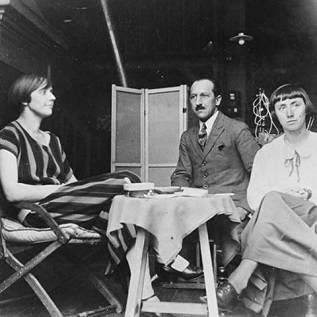
Although Höch's aesthetic of borrowing from popular culture, dismemberment and collage fitted well with that of the Dadaists, the union was an uneasy one, not least because of the inherent sexism of the movement. She also felt uncomfortable with the exhibitionist element of the Dada circle, and was embarrassed by the behavior of some of her peers. In 1922, she ended her relationship with Hausmann.
Mature Period
Towards the end of the 1920s, she had moved away from the group and was starting to make connections with other artists. She became friends with Piet Mondrian, Tristan Tzara and László Moholy-Nagy, and was influenced by the De Stijl movement. She settled in The Hague in the Netherlands in 1926, and started a lesbian relationship with Dutch writer Til Brugman. The couple lived together for the next decade.
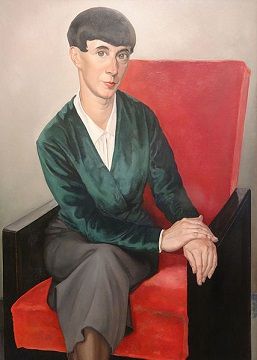
During the rise of the Nazi party in Germany in the 1930s, Höch found herself under attack from the party as a producer of "degenerate art." She was supposed to have an exhibition of her work at the Bauhaus school in 1932, but it was closed by the local Nazi council. She had been designated a "cultural Bolshevik," along with many other Dadaists. She returned to Berlin permanently in 1936. While other artists fled Germany, Höch stayed in her own form of exile. She bought a house near Berlin and lived there throughout the Second World War, hoping that her neighbors would not guess her identity and give her away. She married Kurt Matthies, a businessman and pianist, in 1938. The marriage ended in divorce in 1944.
Late Period
After the War, Höch broke many of her pre-War ties, both artistically and socially. Her work moved away from her figurative montages and veered into the territory of abstraction, which was being explored by many artists at the time. Although she still produced work on a fairly prolific scale, her pieces from this era are less well-known and generally less well-received by critics.
Art historian Dawn Ades visited Höch in her Berlin home in the early 1970s, and found that the artist was "as interested in nature as she was in art." She recalls how "you had to crawl under apple trees to get through the front door. She incorporated leaves and twigs and other organic matter into her collages of the time."
The Legacy of Hannah Höch
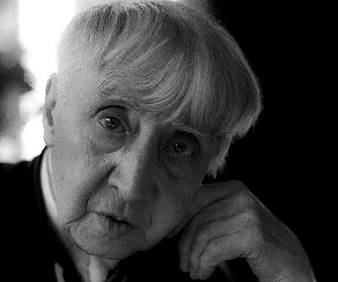
Höch's deliberate attempt to obscure herself during the Second World War, and the fact that she continued to live in her modest home on the outskirts of Berlin until the end of her life, may account for her relative obscurity. The art historian Dawn Ades notes that "she wasn't interested in becoming a celebrity," which perhaps speaks to her early embarrassment at the exhibitionism of the Dada group.
Nevertheless, her pioneering work in photomontage was influential for many later artists, especially for women artists. These include her near-contemporaries German-born Grete Stern and Surrealist artist Claude Cahun, as well as later artists such as Cindy Sherman. The influence of her style has also been traced in the cut-up aesthetic of the punk movement, which came in just after her death in the early 1980s.
Influences and Connections

-
![George Grosz]() George Grosz
George Grosz -
![Raoul Hausmann]() Raoul Hausmann
Raoul Hausmann -
![John Heartfield]() John Heartfield
John Heartfield -
![Kurt Schwitters]() Kurt Schwitters
Kurt Schwitters ![Johannes Baader]() Johannes Baader
Johannes Baader
-
![George Grosz]() George Grosz
George Grosz -
![Raoul Hausmann]() Raoul Hausmann
Raoul Hausmann -
![John Heartfield]() John Heartfield
John Heartfield -
![Kurt Schwitters]() Kurt Schwitters
Kurt Schwitters ![Johannes Baader]() Johannes Baader
Johannes Baader
Useful Resources on Hannah Höch
- Cut with the kitchen knife: the Weimar photomontages of Hannah HöchBy Maud Lavin
- Hannah HöchOur PickBy Ades and Daniel F Herrmann
 Ask The Art Story AI
Ask The Art Story AI